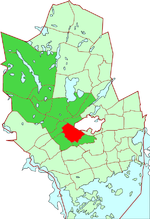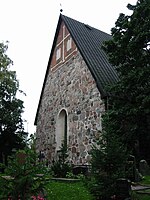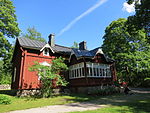Espoo railway station

Espoo railway station (Finnish: Espoon rautatieasema, Swedish: Esbo järnvägstation) is a railway station in the district of Espoon keskus in the city of Espoo, Finland. It is between the stations of Tuomarila and Kauklahti, about 20 kilometres (12 mi) from the Helsinki Central railway station. Before October 25, 2015, Espoo was the station in Espoo city that also served long-distance trains, but since then Leppävaara railway station has had that role in Espoo. The old Espoo station was built in 1903 according to plans by the architect Bruno Granholm. The station was expanded in 1909. The station building has many ornamental details. The station acted as the Espoo station building from 1903 to 1981, and the post office was also moved to the station as soon as it was finished, when the offices of the stationmaster and post officer were combined. The Espoo station is on the bridge over the tracks, and the post office is to the south of the tracks.
Excerpt from the Wikipedia article Espoo railway station (License: CC BY-SA 3.0, Authors, Images).Espoo railway station
Kirkkojärventie, Espoo Espoon keskus (Vanha-Espoo)
Geographical coordinates (GPS) Address Nearby Places Show on map
Geographical coordinates (GPS)
| Latitude | Longitude |
|---|---|
| N 60.205 ° | E 24.656111111111 ° |
Address
Kirkkojärventie 1
02770 Espoo, Espoon keskus (Vanha-Espoo)
Finland
Open on Google Maps







